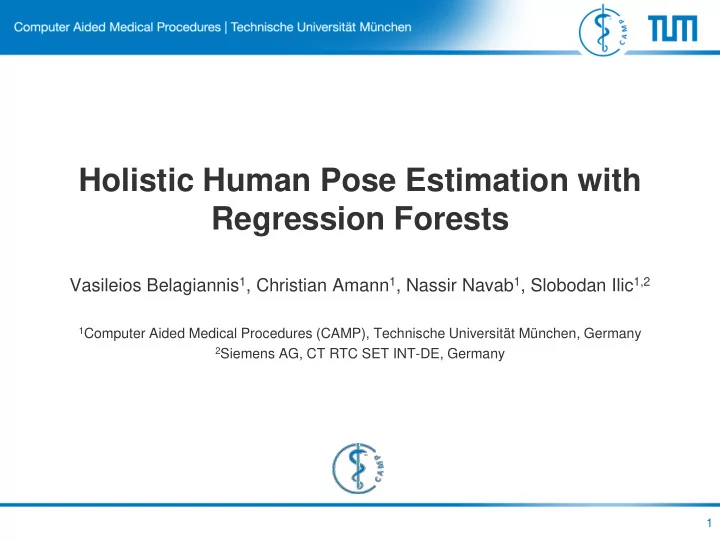

Holistic Human Pose Estimation with Regression Forests Vasileios Belagiannis 1 , Christian Amann 1 , Nassir Navab 1 , Slobodan Ilic 1,2 1 Computer Aided Medical Procedures (CAMP), Technische Universität München, Germany 2 Siemens AG, CT RTC SET INT-DE, Germany 1
Motivation • One-Shot 2D human pose estimation • Less hand-crafted features Belagiannis et al., 3D Pictorial Structures for Multiple Human Pose Estimation, CVPR 2014. Motivation Related Work Method Training Evaluation Conclusion 2
Main Idea • Associate the body pose with image features • Regress the human body joint offsets • Problems – Huge appearance variation – Ambiguity between appearance & geometric pose – Computational cost of mode seeking Motivation Related Work Method Training Evaluation Conclusion 3
Related Work • Holistic approaches + Skeleton inference in one step - Require complete data G. Mori and J. Malik. Estimating human body configurations using shape context matching. In ECCV, 2002. • Part-Based approaches + Rich appearance features - Rely on complex models Y. Yang and D. Ramanan. Articulated pose estimation with flexible mixtures-of-parts. In CVPR, 2011. Motivation Related Work Method Training Evaluation Conclusion 4
Related Work (Part-based) • Andriluka, M., Roth, S., Schiele, B., Pictorial structures revisited: People detection and articulated pose estimation, In CVPR 2009. • Yang, Y., Ramanan, D., Articulated pose estimation with flexible mixtures-of- parts, In CVPR 2011. • Dantone, M., Gall, J., Leistner, C., Van Gool, L., Human pose estimation using body parts dependent joint regressors, In CVPR 2013. Motivation Related Work Method Training Evaluation Conclusion 5
Related Work (Holistic) • Mori, G., Malik, J., Estimating human body configurations using shape context matching, In ECCV 2002. • Rogez, G., Rihan, J., Ramalingam, S., Orrite, C., Torr, P.H., Randomized trees for human pose detection. In CVPR 2008. • Girshick, R., Shotton, J., Kohli, P., Criminisi, A., Fitzgibbon, A., Efficient regression of general- activity human poses from depth images, In ICCV 2011. Motivation Related Work Method Training Evaluation Conclusion 6
Method (Regression forest) • Ensemble of trees • Continuous output • Contribution : Mapping between image patches (HOG features) & the parameter space ( N joints in the 2D space) Phil Cutler – Source: http://www.stat.berkeley.edu/~breiman/RandomForests/ Motivation Related Work Method Training Evaluation Conclusion 7
Method (Prediction) • Bounding-box localization – Rescaled • Random and dense sampling – HOG feature extraction • Vote aggregation • Mode estimation – Contribution : dense-window algorithm Motivation Related Work Method Training Evaluation Conclusion 8
Method (Forest elements) • Entropy (joint- and mean-offsets) Input : pool of randomly extracted image patches P with associated skeleton joint offsets • Goal : node creation for each tree Split function (pool of random tests) Forest formation Info-gain (best test) Motivation Related Work Method Training Evaluation Conclusion 9
Method (Prediction) • Mode estimation – Contribution : dense-window algorithm Motivation Related Work Method Training Evaluation Conclusion 10
Method (Prediction – Mode Estimation) • Forest leaves: joint-offsets • Dense-window algorithm – Mode estimation of a density function – Integral matrices – Deterministic convergence – Dependence: a sliding window – Scalability: number of predictions Motivation Related Work Method Training Evaluation Conclusion 11
Method (Parameters) • Scale Invariance – Bounding-box normalization • Image Patches – Fixed Size • Threshold ρ – Local joint votes Motivation Related Work Method Training Evaluation Conclusion 12
Forest Parameters • Number of trees • Depth of a tree • Patch size Motivation Human Model Training Evaluation Conclusion 13
Evaluation (Datasets) • Football • Image Parse • Volleyball Motivation Human Model Training Evaluation Conclusion 14
Evaluation: Football Dataset PCP Scores Head Torso Upp. Arm Low. Arm Upp. Leg Low. Leg Avg. Our method 0.86 0.98 0.88 0.57 0.92 0.80 0.84 Yang & Ramanan [3] 0.84 0.98 0.86 0.55 0.89 0.73 0.80 Kazemi et al. [19] 0.94 0.96 0.90 0.69 0.94 0.84 0.87 Kazemi et al. [19] + Prior 0.96 0.98 0.93 0.71 0.97 0.88 0.89 Motivation Human Model Training Evaluation Conclusion 15
Evaluation: Image Parse Dataset PCP Scores Torso Upp. Leg Low. Leg Upp. Arm Low. Arm Head Avg. Our method 88.8 80.9 72.8 58.2 27.5 74.1 67.1 Andriluka et al.[4] 86.3 66.3 60.0 54.6 35.6 72.7 59.2 Yang & Ramanan [3] 82.9 69.0 63.9 55.1 35.4 77.6 60.7 Pischulin et al. [2] 92.2 74.6 63.7 54.9 39.8 70.7 62.9 Pischulin et al. [33] + [2] 90.7 80.0 70.0 59.3 37.1 77.6 66.1 Johnson & Ever.[8] 87.6 74.7 67.1 67.3 45.8 76.8 67.4 Motivation Human Model Training Evaluation Conclusion 16
Evaluation: Volleyball Dataset • Proposed dataset • Train on a game • Test on a different PCP Scores Head Torso Upp. Arm Low. Arm Upp. Leg Low. Leg Avg. Our method 97.5 81.4 54.4 19.3 65.1 81.2 63.8 Yang & Ramanan [3] 76.1 80.5 40.7 33.7 52.4 70.5 59.0 Motivation Human Model Training Evaluation Conclusion 17
Conclusion • One-shot 2D human pose estimation • Appearance mapping to body poses using image patches • Efficient prediction with the dense-window algorithm • State-of-the-art results only with HOG features – Random Forest Motivation Human Model Training Evaluation Conclusion 18
Future Work • Learn jointly the appearance features and classifier parameters • Learn the body structure Motivation Human Model Training Evaluation Conclusion 19
Thank you! • Volleyball dataset available at:http://campar.in.tum.de/Chair/SingleHumanPose Motivation Human Model Training Evaluation Conclusion 20
Recommend
More recommend